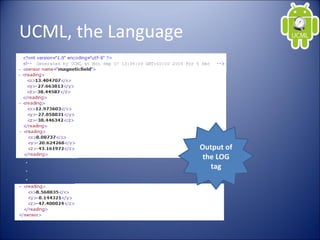UCML
- 1. Abdulrahman M.S. Salman School of Computer Science 2009 Selim.2k@gmail.com Ubiquitous Control Modeling Language for Android An approach towards Android as a Ubiquitous Computing platform
- 2. Outlines âĒ Objectives âĒ Background â XML â Ubiquitous Computing â Googleâs Android â C3 & ODD approaches â What is UCML â UAT âĒ UCML, the Application âĒ UCML Structure âĒ UCML, the Language âĒ UCML Sample Modules âĒ Limitations âĒ Applications âĒ Evaluation âĒ Conclusion
- 3. Objectives âĒ Propose the âOn-Device Developmentâ concept âĒ Provide a software prototype UCML initiative to support the concept. â Simple and friendly application for mobile users. â Being a base for upgrading/extending to complex applications. âĒ Prove UCML within Android platform as a UbiComp system
- 4. XML âĒ Global standard âĒ Defined elements âĒ Special-purpose Languages â WML, UIML, AIMLâĶ <xyz> <x>hello</x> <y foo=âbarâ /> <z foo=âbarâ>hello</z> </xyz>
- 5. Googleâs Android âĒ Free Open Source âĒ Supported by OpenHandsetAlliance and Google Community âĒ Software stack for electronic devices â OS based on Linux 2.6 â Middleware âĒ Libraries (SQLite, OpenGL, WebKitâĶ) âĒ DVM & Core Libraries âĒ Application Framework â Applications (phone native & 3rd party)
- 7. Ubiquitous Computing âĒ the vision of mobile computing where technology will get involved in everything around us.
- 9. What is UCML âĒ UCML is a prototype software for mobile devices runs within Android platform aiming at utilizing smart mobile devices resources. â Consists of modules developed by XML-based language. â Depends on natural language understanding. âĒ Revolves around â Acquire data from built-in sensors â Apply conditions on these data â Fire responses when these conditions are satisfied
- 10. What is UCML UbiComp System Response Situation Sensing Response Sensing Environmen t
- 11. C3 & ODD approaches âĒ The On-Device Development approach so as to develop, execute the software altogether from within the device itself. â Smart, autonomous, resource-utilization âĒ C3 is a paradigm used to describe entities revolve around the power of Computer in processing, the capability to Control surrounding environment, and the facility of Communication between devices in this environment. â C3-compliant
- 12. UAT âĒ Why? âĒ Promote criteria for assessing potential, capability, and competency of devices towards satisfying Ubiquitous Computing conditions and requirement constraints which subsequently facilitate establishing categorization and specifications.
- 13. UAT Synopses Platform: UCML within Android Mobility (accompanied, wearable, embedded) Accompanied: hand-held Category (Tab, Pad, Board) Tap Context-aware (adaptive) depend on the application of a UCML module Running all the time Yes Being everywhere Yes Networked Interconnectivity In-development (future work) Input Sensor-oriented Internet-enabled Yes On-Device development/Configuration Yes C3-Compliant Yes
- 19. UCML, the Language <ucml> <sensor name="[sensor_name]"> <reading type="[reading_type]" [other_attributes]=â â/> <response action="[response_action]" [other_attributes] =â â/> </sensor> </ucml>
- 20. UCML, the Language <sensor name="[sensor_name]"> âĒ sensor_name: â accelerometer â magneticfield â orientation â temperature.
- 21. UCML, the Language <reading type="[reading_type]" [other_attributes]=â â/> âĒ reading_type: â threshold â Range âĒ other_attributes â Threshold â All âĒ x, y, z âĒ xmin, ymin, zmin, xmax, ymax, zmax
- 22. UCML, the Language <response action="[response_action]" [other_attributes] =â â/> response_action: other_attributes enable feature disable feature notify msg vibrate pattern, repeat sendsms destination, sms senddata destination, data, port openweb web dialnumber number
- 23. UCML, the Language <ucml> <sensor name="[sensor_name]"> <log filename="[file_name]" period=â[time_in_secs]"/> </sensor> </ucml> âĒ file saved on /data/data/[package]/files/ [file_name].xml
- 24. UCML, the Language . . . Output of the LOG tag
- 25. UCML Sample Modules <ucml> <sensor name="accelerometer"> <reading type="threshold" threshold="8"/> <response action="notify" msg="hi the Accelerometer threshold fired!!!"/> </sensor> </ucml>
- 26. UCML Sample Modules <ucml> <sensor name=âmagneticfield"> <reading type="threshold" all="yes" x="-2" y="5" z="-9"/> <response action="vibrate" pattern=â300 500 700" repeat="no"/> </sensor> </ucml>
- 27. UCML Sample Modules <ucml> <sensor name="orientation"> <reading type="range" all="no" xmin="10" ymin="8" zmin="-1" xmax="15" ymax="12" zmax="3"/> <response action="sendsms" destination="07928610611" sms=âI ve moved the phone!!!"/> </sensor> </ucml>
- 28. UCML module live
- 29. Applications âĒ monitoring, âĒ controlling, âĒ logging, âĒ gesture recognition, âĒ and interaction with devices.
- 30. Limitations âĒ Explicit Communication with remote sensors and actuators. âĒ Rich framework. âĒ Auto-Complete feature. âĒ Deployment as stand-alone application. âĒ Running as a service. âĒ Android platform is new in the market !!!
- 31. Evaluation âĒ Target users: Digital Generation. â And others interested. âĒ Age: 7 to 35 âĒ Informal Survey: 7 individuals 24-35 years old âĒ Result: â Enjoyable â Extraordinary and Enjoyable
- 32. Conclusion âĒ ODD, C3, and UAT have been defined. âĒ UCML discovers a new interface for end-users which will enrich the user experience in HCI. âĒ The ODD approach is a new trend and would face some reluctance. âĒ Android is promising and is always being updated. âĒ Android is excellent for Ubiquitous Computing scenarios. âĒ Current UCML version is an initiative prototype software represents a basic building block for further development and upgrades.
- 33. Qs
- 34. Tools and Technologies âĒ Eclipse IDE, ADT plug-in âĒ Android SDK 1.5, Android Emulator âĒ XML âĒ Java syntax, JDK tools âĒ Adobe Illustrator, IconArchive.com âĒ OpenIntents SensorSimulator
- 35. Ubiquitous Computing âĒ Ubiquitous smart devices â Tabs: Inch-scale devices (mobile phones) â Pads: foot-scale devices (laptops) â Boards: yard-scale interactive displays (surface computers)
Editor's Notes
- #6: Android is not for a special hw. It can be ported to any device that can load the linux kernel e.g. netbooks A group of 47 technology and mobile companies aims at supporting mobile phone industry through open source projects particularly Android Linux version 2.6 Services include hardware drivers; power, process and memory management; security and network. OpenGLÂ - The Industry Standard for High Performance Graphics DVM makes developer are free from license issues coz it depends in apache harmony Application Framework Abstraction for hardware access; manages application resources and the UI; provides classes for developing applications for Android
- #8: is a post-desktop model of human-computer interaction in which information processing has been thoroughly integrated into everyday objects and activities. Tabs: Inchâscale devices (e.g. smart mobile phones), 2) Pads: footâscale devices (e.g. laptops), 3) Boards: yardâscale interactive displays (surface computers) This classification is not precise because ubicomp it is not about the device itself, it is about the application within the device
- #10: an XML-based language aiming at utilizing the local resources of smart mobile devices and making mobile phone users aware and involved in contributing to technologies existed on their hands. UCML focuses on developing ubiquitous control applications within smart mobile devices by acquiring data from attached sensors, applying conditions on these data, and firing responses when these conditions are satisfied. It has been designed to be friendly and easy language that is suitable for all mobile users.
- #12: Before we proceed Besides the above mentioned UAT here are two terms should be identified This supports bring devices to the forefront and also supports Ubicomp by avoiding use of Desktops
- #19: SAX vs DOM RELAX-NG vs XSD
- #31: Various UCML modules have been tested (see chapter 6 and appendix 1) to demonstrate the functionality and usability underneath mobile phone platforms. The testing results meet the requirements designated for UCML. However, Current version of UCML has encounters some limitations: 1) It cannot communicate with remote sensors and actuators explicitly (i.e. senddata, sendsms, and dialnumber can communicate with preconfigured remote devices implicitly). 2) The current number of responses and readings formats cannot represent such a rich framework for high usability. 3) The Auto-Complete feature has not developed yet. 4) UCML Module cannot run as a service in the background or deployed as a standalone application (i.e. it can only run within UCML application). 5) UCML is designed only for Android platform which is not widely used till the moment. Solutions for these limitations are all tasks for future work in UCML development.
- #32: Do not restrict the people with a specific interface and tell this the easiest
- #33: 2- I m both afraid and happy that a new sdk would be released while I m with u 2day Happy coz of progress; afraid coz I ve 2 upgrade ucml 2 The ODD approach is a new trend and would face some reluctance because it is dissimilar to the currently existing approaches of usability in mobile devices.
- #35: RELAX-NG: more friendly and easy to use and can be converted to other types Jarsigner.exe, keytool.exe


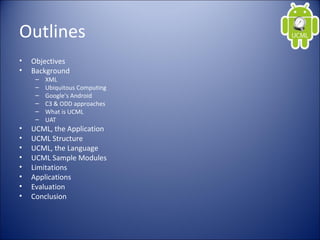
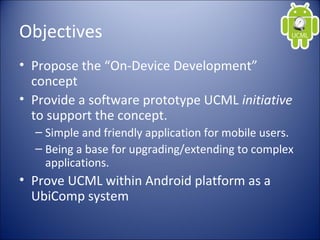
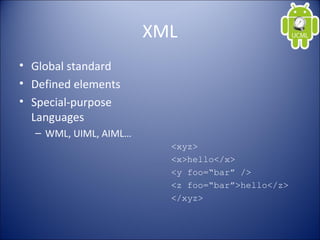
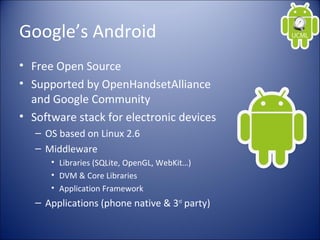







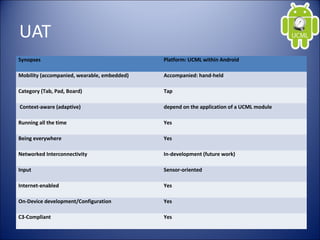





![UCML, the Language
<ucml>
<sensor name="[sensor_name]">
<reading type="[reading_type]" [other_attributes]=â â/>
<response action="[response_action]" [other_attributes] =â â/>
</sensor>
</ucml>](https://image.slidesharecdn.com/ucml-151007201937-lva1-app6892/85/UCML-19-320.jpg)
![UCML, the Language
<sensor name="[sensor_name]">
âĒ sensor_name:
â accelerometer
â magneticfield
â orientation
â temperature.](https://image.slidesharecdn.com/ucml-151007201937-lva1-app6892/85/UCML-20-320.jpg)
![UCML, the Language
<reading type="[reading_type]" [other_attributes]=â â/>
âĒ reading_type:
â threshold
â Range
âĒ other_attributes
â Threshold
â All
âĒ x, y, z
âĒ xmin, ymin, zmin, xmax, ymax, zmax](https://image.slidesharecdn.com/ucml-151007201937-lva1-app6892/85/UCML-21-320.jpg)
![UCML, the Language
<response action="[response_action]" [other_attributes] =â â/>
response_action: other_attributes
enable feature
disable feature
notify msg
vibrate pattern, repeat
sendsms destination, sms
senddata destination, data, port
openweb web
dialnumber number](https://image.slidesharecdn.com/ucml-151007201937-lva1-app6892/85/UCML-22-320.jpg)
![UCML, the Language
<ucml>
<sensor name="[sensor_name]">
<log filename="[file_name]" period=â[time_in_secs]"/>
</sensor>
</ucml>
âĒ file saved on /data/data/[package]/files/
[file_name].xml](https://image.slidesharecdn.com/ucml-151007201937-lva1-app6892/85/UCML-23-320.jpg)
